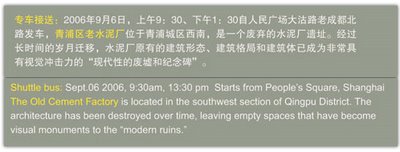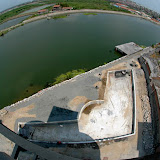黄盒子·青浦:中国空间里的当代艺术
A Yellow Box in Qingpu: Contemporary Art and Architecture in a Chinese Space
星期三, 九月 20, 2006
星期日, 八月 27, 2006
SCHEDULE
 免费大巴: 老成都北路-大沽路,9:00 14:00 15:00
免费大巴: 老成都北路-大沽路,9:00 14:00 15:00点击左图浏览更多图片
click the left image to view more images
展览名称:“黄盒子·青浦:中国空间里的当代艺术”
展览时间:2006年9月6日——10月6日
展览地点:青浦区小西门
开幕晚会
时间:2006年9月6日19:00—22:00
地点:青浦水泥厂废墟
交通:由小西门展区乘船
节目:音乐+多媒体演出
联系人
何海艳小姐
电话:021-39716666-2041,69730977
传真:021-69730977
邮箱:qpxcjs@shqp.gov.cn
9月6日
10:00 报到(青浦宾馆)
10:00-12:00 参观“黄盒子”展览现场以及青浦新城的实验建筑现场(统一专车接送)
12:00 午餐
13:30-16:30 学术研讨会(小西门现场)
14:00-16:30 来宾参观青浦新城实验建筑现场、小西门展览现场(统一专车接送)
17:00-18:00 展览开幕式
18:00-19:00 所有来宾乘船到达“老水泥厂”
19:00-20:00 开幕式酒会(party)
20:00-21:30 多媒体表演与实验音乐表演

-----------------------------------------------------------
Title: A Yellow Box in Qingpu: Contemporary Art and Architecture in a Chinese Space
Date: 6th Sept to 6th October, 2006
Venue: Xiao Ximen (Minor West Gate), Qingpu Town, Shanghai
(Qingpu Town is about 45 minutes by car from Shanghai Art Museum)
EVENING PARTY
Time: 19:00-22:00 6th September 2006
Venue: Ruins of Qingpu Cement Factory
Programs: Music + Mixed media performance
(rowing-boats will ferry guests between the exhibition and the cement factory from 19:00. The boat ride is 20 minutes; by car the journey is 5 minutes.)
CONTACT
Ms. He Haiyan
Fax:021-69730977
E-mail: qpxcjs@shqp.gov.cn
Tel: 021-39716666-2041,69730977
SCHEDULE
6th Sept.
10:00 Reception: Qingpu Hotel.
09:00 Distinguished guests and speakers board shuttle buses at Old Chengdu North Road and Dagu Road to Qing Cheng Company in Qingpu District.
10:00-12:00 Visit A Yellow Box In Qingpu and Qingpu Newcity experimental architecture sites (shuttle bus provided).
12:00 Lunch
13:30 Distinguished guests and speakers board shuttle buses at Old Chengdu North Road and Dagu Road
13:30-16:30 Academic Forum (Small West Gate)
14:00-16:30 Visit Qingpu Newcity experimental architecture sites and Small West Gate exhibition (shuttle bus provided).
17:00-18:00 Opening Ceremony
18:00-19:00 All guests go to the Old Cement Factory by boats.
19:00-20:00 Opening Party
20:00-21:30 Mixed media and experimental music performance

---------------------------------------------------------------------------------
星期六, 八月 26, 2006
黄盒子·青浦:中国空间里的当代艺术
展览时间:2006年9月6日——10月6日
展览地点:青浦区小西门
开幕晚会
时间:2006年9月6日19:00—22:00
地点:青浦水泥厂废墟
交通:由小西门展区乘船
节目:音乐+多媒体演出
联系人
何海艳小姐
电话:021-39716666-2041,69730977
传真:021-69730977
邮箱:qpxcjs@shqp.gov.cn
9月6日
10:00
报到(青浦宾馆)
10:00-12:00
参观“黄盒子”展览现场以及青浦新城的实验建筑现场(统一专车接送)
12:00
午餐
13:30-16:30
学术研讨会(小西门现场)
14:00-16:30
来宾参观青浦新城实验建筑现场、小西门展览现场(统一专车接送)
17:00-18:00
展览开幕式
18:00-19:00
所有来宾乘船到达“老水泥厂”
19:00-20:00
开幕式酒会(party)
20:00-21:30
多媒体表演与实验音乐表演
主题阐述
任何经历过历史汰选而建立了自觉判断标准的艺术品类,都同时建构起它特定的观赏方式。自十九世纪以来,现代美术馆以其纯粹、明亮、中性的空间构造确立了一种“规范的”公共展示-观赏制度。美术馆的空间被规定为White Cube(白方空间),一种“白盒子”,它是一个可以替代教堂的建筑容器,也是特定意义构成的公共场域,不同类型的艺术实践皆可在这个圣殿般的空间中呈现为“作品”——个人性的观看主体膜拜、凝视的对象。然而,“白盒子”却从本质上呈现为一种隔离:将所有作品与它原本发生的生活世界隔离开来;将创作情境与观赏情境隔离开来;将审美体验空间与日常体验空间隔离开来。由于此隔离而生成的,是一种特定的凝注-沉思的意义空间(这也是Muse女神庇护下的Museum的源初涵义),同时也是一个将艺术对象化的空间。
“黄盒子”是由中国美术学院发起,为应对“白盒子”机制而提出的一系列当代艺术创作与展示计划,旨在探索一种中国式的展示空间与观看机制。这一概念的提出,既是对传统中国式空间的一种展示学探索,又是对文人书画精神的一种当代艺术的诠释。2005年,“黄盒子”计划在台北市立美术馆成功举办了“黄盒子:台湾当代书画展”,该展致力于在美术馆既有空间中再造一个中介空间,借以呈现出中国传统观赏经验的一些具体格式。在此基础上,“黄盒子”当代艺术与展示计划又将迈出关键的一步。
“小西门”是上海青浦区政府保护修建的一个古镇民居建筑群落,是目前由地方政府主导的传统/民间文化复兴、创意文化再生产的一个颇具代表性的案例。经过三年的努力,小西门传统民居群落保护修建工程已经胜利完成。藉小西门工程落成之机,中国美术学院协同亚洲艺术文献库(AAA)、《时代建筑》将在上海青浦区政府、上海市青浦区新城公司的支持下,举办“黄盒子?青浦:中国空间里的当代艺术”大型学术展览。本次展览以中国式空间向当代艺术发问,拟邀请海内外20余位当代艺术家,以绘画、录像、摄影、装置、多媒体戏剧等多种实验艺术形式应对、演绎小西门的传统中国式空间。同时,本次展览还邀请了来自不同国家的10数位著名建筑师,采用现场制造、现成品重组、空间叠印等方式,在小西门民居群落中展示其作品及创意,探索传统空间与当代建筑的关系、表达与展示的关系,在中国式空间中检验、思考当代建筑的种种问题。
目前中国各地正在兴起一场修建美术馆的热潮,美术馆的空间营造是否一定要遵循规范化的观看制度?中国悠久而精深的观赏文化在美术馆的系统中是否尚有可为之处?古典的观赏经验对当代美术馆建筑的形态与空间探索具有何种意义?中国本土的空间和视觉实验以何种方式回馈世界?这是“黄盒子”计划指向的问题。小西门并非专为艺术展示设计的场所,它本是日常生活的建筑,今天,由于人们生活形式的改变,它成为我们难以回归的家园。在中国各地,许多像小西门这样的建筑或者消失,或者成为旅游业的秀场。在这种情况下,如何在保留中国传统建筑视觉记忆的同时,赋予它新的意义和活力?本次展览将以小西门为研究对象和创作现场,使当代艺术走出美术馆空间,脱离“白盒子”中灯光魔术的保护,在传统中国式空间中探讨当代艺术与实验建筑的表现潜力,以中国的日常生活空间限定、激发当代艺术的创造形态,实现传统空间形态的意义更生。
青浦既是传统的中国水乡,同时又是当代建筑的重要工作现场,这一特定的文化格局使青浦成为中国当代视觉文化建构的实验室,一个现实世界的“黄盒子”。在本次展览中,我们将在中国式的空间中展示和思考当代艺术与建筑的诸种实验,我们相信,“黄盒子?青浦:中国空间里的当代艺术”将为当代艺术创作与建筑文化带来一种新的思考向度与发展契机。
策展团队
高士明
策展人、中国美术学院展示文化研究中心主任
张颂仁
独立策展人,中国美术学院客座教授
胡项城
艺术家,小西门建筑群落艺术总监
组织机构
主 办:中国美术学院
协 办:《时代建筑》、《A+U》
承 办:青浦新城区建设发展(集团)有限公司
文献协作:亚洲艺术文献库
学术研讨会
时间:2006年9月6日13:30至16:30
地点:青浦区小西门
本次展览期间,将邀请国际相关领域的重要理论家及艺术家赴小西门出席研讨会,与会代表将围绕以下议题进行讨论(该议题亦作为“黄盒子”计划向艺术界、建筑界同仁提出的一份问卷):
1.当代艺术的展示空间与意义建构机制是怎样的?
2.怎样看待美术馆空间对艺术创作的支持与限定性?
3.如何看待中国传统观赏文化与美术馆观看制度的关系?
4.你理想中的美术馆是怎样的?
5.如何理解“中国式空间”?它是否存在?
6.中国日常空间里的当代艺术创作是否可能?
7.如何看待中国传统空间与经验的建筑学转化?
8.文化遗产的合法性?文化传统与博物馆对象、旅游业景观的关系?
9.在社会发展中我们失落了什么?在遗产保护中我们失落了什么?
10.如何面对社会生活的博物馆化和对历史传统的破坏?
11.历史、传统对我们意味着什么?
12.怎样看待已经失去的历史和未来的历史?
13.文化身份是现实还是想象?怎样看待建筑师对“普通城市”的焦虑和对可辨识性的欲望?
14.无建筑师的建筑、建筑史之外的建筑意味着什么?
15.如何看待青浦建筑实践及其视觉生产?它对青浦的意义?
参展艺术家
艺术家:
吴山专(汉堡-上海)、邱志杰(北京)、王冬龄(杭州)、梁志和(香港)、吴俊勇(杭州)、刘大鸿(上海)、刘韡(北京)、高世强(杭州)、Yondonjunain Dalkh-Ochir(蒙古)、叶放(苏州)、张慧(北京)、郑端祥(杭州)、朱玺(上海)、于彭(台湾)、Inga Svala Thorsdottir(冰岛)、楼笙华(杭州)、邱黯雄(上海)、薛君(北京)、孙逊(杭州)、白双全(香港)、郑在东(台湾)、倪柯耘(杭州)、廖文峰(上海)、谢曹闽(美国)、嬲小组、郑文昕(杭州)、Intravision Group(挪威)、小蓧顺子、胡 非非、总体艺术小组(北京-杭州)、色彩调查小组(上海)等。
建筑师:
Arata Isozaki、Benjamin Wood、David Chipperfield、泉本晋一、大舍建筑、张斌、马清运、刘家琨、张雷、Rem Koolhaas、J. C. Sancho Osinga-Sol Madridejos、文筑国际、王家浩、童明、李凯生、祝晓峰、张永和、郑湘竹、董晓波、某群众建筑师等。
星期五, 八月 25, 2006
A Yellow Box in Qingpu: Contemporary Art and Architecture in a Chinese Space
Title: A Yellow Box in Qingpu: Contemporary Art and Architecture in a Chinese Space
Date: 6th Sept to 6th October, 2006
Venue: Xiao Ximen (Minor West Gate), Qingpu Town, Shanghai
(Qingpu Town is about 45 minutes by car from Shanghai Art Museum)
EVENING PARTY
Time: 19:00-22:00 6th September 2006
Venue: Ruins of Qingpu Cement Factory
Programs: Music + Mixed media performance
(rowing-boats will ferry guests between the exhibition and the cement factory from 19:00. The boat ride is 20 minutes; by car the journey is 5 minutes.)
CONTACT
Ms. He Haiyan
Fax:021-69730977
E-mail: qpxcjs@shqp.gov.cn
Tel: 021-39716666-2041,69730977
SCHEDULE
6th Sept. 10:00 Reception: Qingpu Hotel.
09:00 Distinguished guests and speakers board shuttle buses at Old Chengdu North Road and Dagu Road to Qing Cheng Company in Qingpu District.
10:00-12:00 Visit A Yellow Box In Qingpu and Qingpu Newcity experimental architecture sites (shuttle bus provided).
12:00 Lunch
13:30 Distinguished guests and speakers board shuttle buses at Old Chengdu North Road and Dagu Road
13:30-16:30 Academic Forum (Small West Gate)
14:00-16:30 Visit Qingpu Newcity experimental architecture sites and Small West Gate exhibition (shuttle bus provided).
17:00-18:00 Opening Ceremony
18:00-19:00 All guests go to the Old Cement Factory by boats.
19:00-20:00 Opening Party
20:00-21:30 Mixed media and experimental music performance
THEME
Any tradition of art that has established an independent system of aesthetic criteria must also have to create by necessity its own particular form of connoisseurship. However, since the 19th century, the European tradition of art has found a “standard” system of exhibition and art appreciation based upon the modern art museum – a system which has now become seemingly universal. The modern art museum is a “neutral” exhibition space, pure and evenly lit, earning the moniker, the “white cube”. The “white cube” is an architectural space that echoes the Christian religious space; it resonates with spiritual references – there, a wide range of art works may be canonised as “works of fine art”. In it, art works are turned into objects worthy of adulation and focused gazing. On the other hand, the “white cube” is also a system of partitioning from nature, separating art works from the living world out of which it arises, while keeping apart the creative situation from the conditions of connoisseurship, and separating the space of art appreciation from that of daily experience. As a result of this divide, it has caused a particular kind of focused gaze that created a space of meditation.
“Yellow Box” is a project initiated by the Visual Culture Research Centre of China Academy of Art. Its purpose is to investigate issues about contemporary art, creativity and culture of connoisseurship in response to the modern “white cube”. This project intends to investigate issues of connoisseurship and display that are embedded in Chinese traditional spaces; meanwhile it also intends to reinterpret traditional literati spirit in light of contemporary art. In 2005, the first exhibition of “Yellow Box” subtitled “Contemporary Calligraphy and Painting in Taiwan” was held at the Taipei Fine Art Museum. That exhibition experimented with solutions for displaying the subtlety of literati art within the sterile “white cube” by either building mediating structures or setting up viewing procedures. Based on that exhibition’s experiment, the present “Yellow Box” project continues the research in exhibition practice by studying contemporary art and architecture.
Xiao Ximen (Minor West Gate) is a project of a newly constructed traditional vernacular architecture built under the auspices of the Qingpu District Government. It is a remarkable example of efforts to revive traditional/vernacular culture and the creative industry. The project was spearheaded by the local government, and is the result of 3 years’ intensive creative labour. In celebration of the realisation of this architectural dream, the China Academy of Art, in cooperation with the Time+Architecture Magazine, will present this exhibition and forum with support of the Qingpu District Government. Over 40 artists and architects have been invited to create and display works of different media including architectural models, paintings, photography, video, installation and experimental mix media productions. The artists have been invited to interpret and respond to this quarter of wood-frame vernacular space that is laden with cultural definitions.
At present there is a rage of building art galleries and art museums throughout China. It is therefore important to ask questions such as: Does the space of museums have to follow the canonical spectator regime? Will the traditional culture of intimate appreciation still retain its charm in the museum system? What is the significance of the classical experience in art appreciation to the configuration of space in contemporary architecture? These are the kind of questions that the “Yellow Box” hopes to illuminate. Xiao Ximen (Minor West Gate) is not a venue designed especially for art display. It is the architecture of daily life. Nowadays, as people change their life style, this type of architecture has become a symbol of home that we can only experience from exile. In China, places like Xiao Ximen have either vanished or turned into tourist attractions. In this situation, the question is: how do we retain traditional visual memories, and at the same time endow them with fresh significance and activity.
The exhibition takes the Xiao Ximen (Minor West Gate) group of buildings as the subject of investigation and experimental space for contemporary art, seeking to discover hidden potentials for different artistic media in such a place of living and working, while also keeping in mind the parameter of Chinese daily activities. This project hopes to stimulate new creative attitudes for contemporary art and bring to fore the implicit cultural significance hidden in vernacular architectural spaces. This is done by building a bridge linking traditional culture and the creative industries, so as to uncover the mechanics of interdependence between native resources and cultural creativity.
The exhibition hopes to contribute to the programme of the Shanghai Biennial 2006. Our aim is to cross the barrier separating art exhibitions and extended urban spaces. Qingpu is not only a traditional town, but also an important experimental studio of contemporary architecture and a “Yellow Box” in the real world. This experimental exhibition format will provide a new platform for displaying Shanghai’s creative energy, and hope to contribute to cultural development of the region.
ORGANISATION
Presented by: China Academy of Art
In Association with: A+U, Time+Architecture Magazine
Supported by: Shanghai Qingpu Newcity Construction Development (Group) CO., LTD
Documentation by: Asia Art Archive
CURATORS
Gao Shiming (Director of Visual Culture Research Centre, China Academy of Art)
Chang Tsong-zung (Curator and Critic, Guest Professor of China Academy of Art)
Hu Xiangcheng (Artist and architect of Xiao Ximen)
ARTISTS
Alan Xie(USA), Gao Shiqiang(China), Intravision Group ( Norway), Leung Chi Wo (China, Hongkong), Liao Wenfeng(China), Liu Dahong(China), Liu Wei (China), Lou Shenghua(China), Ni Keyun(China), Pak Sheung Chuen (China, Hongkong), Qiu Anxiong(China), Qiu Zhijie (China), Ye Fang (China), Sun Xun (China), Total Art Group (China), Wang Dongling (China), Wu Junyong (China), Wu Shanzhuan (China), Xue Jun (China), Yondonjunain Dalkh-Ochir(Mongolia), Yu Peng(Taiwan,China), Zhanghui (China), Zheng Duanxiang (China), Jian Group, Zheng Wenxin(China), Zheng Zaidong (Taiwan,China), Zhu Xi (China), Junko Koshino,Hu Feifei, etc.
ARCHITECTS
Arata Isozaki(Japan), Atelier Deshaus (China), Benjamin Wood(USA), CA-Group(China), David Chipperfield(UK), Kensyo, J.C(Japan), Li Kaisheng(China), Liu Jiakun (China), Ma Qingyun (China), Rem Koolhaas(Dutch), Sancho Madridejos(Spain), Tong Ming(China), Wang Jiahao (China), Zhang Bin (China), Zhang Lei (China), Zhang Yonghe (China), Zheng Xiangzhu(China), Zhu Xiaofeng(China),Dong Xiaobo and a Chinese folk Architect etc.
OPENING PROGRAMME
Academic Forum: 13:30 – 16:30, 6th September 2006
Opening: 17:00-19:00, 6th September
Evening Party: 19:00 – 22:00, 6th September
The exhibition opens on 6th September, the day after the Shanghai Biennial. A forum will be held in the afternoon, with an opening reception in the late afternoon and a special all night celebration party (with experimental music and mixed media performance) at a disused cement factory nearby.
ACADEMIC FORUM
Date: 13:30—16:30, 6th September 2006
Venue: Xiao Ximen (Minor West Gate), Qingpu Town
The Academic Forum will engage with the issues of “Exhibition Practice and Mechanics of Significance”, “China’s Traditional Culture of Connoisseurship and Contemporary Art”, “Chinese Approaches to Contemporary Art”, “Architectural Practice and Visual Production in Contemporary China”.
1. What is the relationship between contemporary exhibition practice and the mechanics of significance?
2. What are the supports and limitations museum spaces bring to art practice?
3. What is the relationship between Chinese traditional culture of appreciation and museum-based connoisseurship?
4. Is there an ideal museum?
5. Is there “a Chinese space”? Does it exist?
6. Is it possible to build a contemporary art practice in Chinese daily space?
7. What are architectural practices in Chinese traditional space and how is it visually experienced?
8. What is the “legitimacy” of culture heritage? How can cultural tradition avoid the label of “intangible heritage”? How do we define tradition while keeping it distinct from the objects of museology or tourist attractions?
9. What do we lose in the spectacle of development? What do we lose in the process of culture heritage protection?
10. How should we respond to the museumisation of social life and the damage to historical tradition?
11. What do history and tradition mean to us in an age of virtual reality?
12. How do we address the history that we have lost? Is there a history of the future?
13. Is culture identity a reality or just an imagination? From the architect’s viewpoint, how should he address the anxiety of “generic cities” and the desire for local identification?
14. What is the implication of non-architectural buildings and architecture beyond the history of architecture?
15. What do you think about the architectural practice in Qingpu and its visual production?
